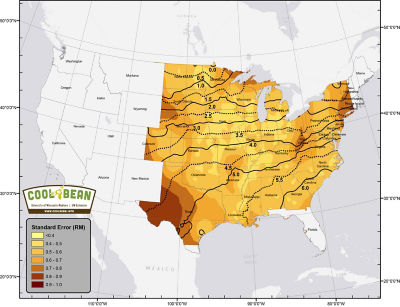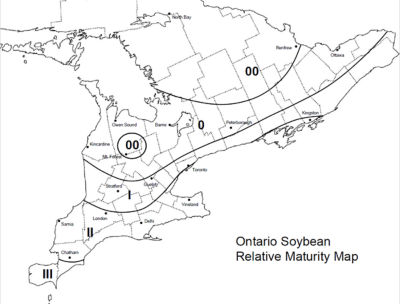5 MIN READ
Late Soybean Planting Recommendations
May 29, 2025
- Environmental conditions can delay soybean planting beyond the planting window recommended for maximizing yield potential. Delayed planting requires changes in management tactics.
- Management considerations for late-planted soybean fields include changes in maturity group, seeding rates, and row spacing, as well as addressing weed, insect, and disease management issues.
Soybean planting dates in the Midwest have shifted earlier because of higher yield potential soybean products and seed treatment protection against early season, soilborne diseases associated with cooler, wetter soils. However, in some years planting is dramatically delayed, and producers may need to consider moving to an earlier maturity group.
Seeding Rate
The recommended seeding rate in the Midwest for soybean when planted in late April and May is 140,000 seeds per acre to achieve an average final stand of 100,000 plants per acre. As planting is delayed into June, it is recommended that seeding rates be increased. In Ohio, according to Ohio State University, the recommended seeding rate for the first half of June is 150,000 to 175,000 seeds per acre. For the second half of June, their recommendation is to plant 175,000 to 200,000 seeds per acre.1 In Wisconsin, the recommend seeding rate for a mid-June planting date is 200,000 seeds per acre with a target of 180,000 plants per acre at harvest.2 In eastern Canada, a 10% increase of the standard rate used in a field at mid-May is recommended when planting is delayed until mid-June.3
Why Are Increased Seeding Rates Recommended for Late-planted Soybean?
A higher seeding rate can increase the likelihood of setting a higher number of pods to help increase yield potential. A higher seeding rate can also increase canopy density, shading out weeds and helping to reduce soil evaporation by “closing the row” more quickly.
Row Spacing
If planting is delayed in the Midwest until June, using a narrow row spacing (less than or equal to 15 inches) can help maximize yield potential by capturing more light for photosynthesis and “closing the row” more quickly, which helps with weed control and reducing soil evaporation.
Will an Increased Seeding Rate and/or Narrow Rows Increase the Risk of White Mold?
Fields with a history of white mold may be more at risk with increased seeding rates and narrow rows. White mold risk may be greater if the soybean field blooms later, over an extended period, and the weather is cool, wet, and humid. Monitoring the weather conditions during bloom is advisable, and a fungicide application may be necessary.5
Weed Management
Soybean are usually planted late because of wet conditions, and weed control might not be a priority in the rush to plant as soon as conditions are favorable. While winter annual weeds may have essentially completed growth and be setting seeds, the priority in many fields should be summer annual weeds that may be emerging or will emerge soon. A 2,4-D ester formulation is usually not an option, as the 7-day waiting period will delay planting even longer. Consult with your herbicide provider for available burndown products. In cases where weeds may have resistance to glyphosate or other post-emergence herbicides, tillage may be an option. The use of a residual herbicide can help provide early control, and when used in combination with narrow rows, they can provide an effective herbicide management program with late soybean planting.6
Planting Soybean Late Usually Results in an Open Canopy for a Longer Period of Time. Will This Result in Late-season Weed Escapes?
This can be particularly true for fields with a history of waterhemp and for fields where a residual product was not applied with either a burndown herbicide or tillage. If a residual herbicide was not applied prior to planting or during early post-emergence, continue to scout the fields and consider a post-emergence herbicide product to control late-emerging weeds.
Insect Management
Delayed soybean planting, particularly if it is a single field in the landscape, may result in the attraction of some insect pests and lower populations of other insect pests. Later planting of soybean often results in less injury by seedcorn maggot and bean leaf beetle, while soybean aphid, stinkbug, and grasshopper injury may be increased. Soybean aphids developing on vegetative stages of soybean reproduce at higher rates than when feeding on early reproductive stages, which may allow soybean aphid populations to reach the economic threshold of 250 aphids per plant at a faster rate in late-planted fields.4
Seed Treatments
Planting later than normal is usually associated with warmer soil conditions that enable the seed to germinate quickly and emerge from the soil in less than week. Therefore, the need for a seed treatment may not be as great as when planting in the early spring. However, some root diseases such as Phytophthora root rot may still be of concern, and the use of treated seed in fields with a history of this disease should be considered.4
Maturity Group
Many universities recommend planting an earlier maturity group (MG) soybean product when the date of planting is delayed until mid-June in the upper Midwest and Eastern Canada. Selecting a soybean product that is no more than 0.5 MG earlier than what is normally planted offers a balance between maximizing yield potential and limiting injury from frost (See Figures 1 and 2 for recommended maturity group). A general rule of thumb is that a three-day delay from the optimal planting date for your area only results in a one-day delay of maturity, as later-planted soybean plants mature more quickly than those planted during the normal planting window.2,3,4
Sources
1Lindsey, L. and Ortez, O. (Eds.) 2024. Ohio Agronomy Guide, 16th Edition. The Ohio State University Extension. https://extensionpubs.osu.edu/ohio-agronomy-guide-16th-edition/
2Conley, S. and Gaska, J. 2015. Considerations for switching soybean maturity groups for delayed plantings. Integrated Pest and Crop Management. University of Wisconsin Extension. https://ipcm.wisc.edu/blog/2015/06/considerations-for-switching-soybean-maturity-groups-for-delayed-plantings-4/
3Bagg, J., Ball, B., Banks, S., Baute, T., Bohner, H., Brown, C., Cowbrough, M., Dyck, J., Ferguson, T., et al. 2017. Soybeans. In, Agronomy Guide for Field Crops. Ontario Ministry of Agriculture, Food, and Rural Affairs. Publication 811. Queen’s Printer for Ontario. https://www.ontario.ca/page/publication-811-agronomy-guide-field-crops
4Staton, M. and Anderson, E. 2019. Late-planted soybean recommendations. Michigan State University Extension. https://www.canr.msu.edu/news/late_planted_soybean_recommendations
5Smith, D. and Telenko, D. 2019. How will delayed planting influence crop diseases in 2019? Badger Crop Doc. University of Wisconsin Extension. https://badgercropdoc.com/2019/05/21/will-delayed-planting-influence-crop-diseases-2019/
6Burns, E. and Sprague, C. 2019. Weed control recommendations for late and prevented planting. Michigan State University Extension. https://www.canr.msu.edu/news/weed-control-recommendations-for-late-and-prevented-planting
1314_109355

